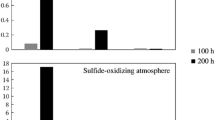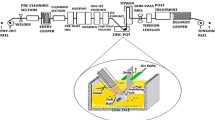Abstract
The interaction between stress and galvanic during the corrosion process of 5050 aluminum alloys was studied and the evolution of mechanics properties was indicated. Electrochemical impedance technique and scanning electron microscopy were used to analyze the surface electrochemical states and the corrosion morphology. At the same time, corrosion kinetics and thermodynamic theory were used to analyze the influencing mechanism of the stress factor and the galvanic factor. The results show that both of galvanic factor and tensile stress factor can increase the corrosion potential of aluminum alloys and result in the corrosion resistance decrease. With decreasing corrosion resistance, the mechanical properties of aluminum alloys decrease. These phenomena are attributed to two reasons: One is that aluminum alloys may under the condition of anodic polarization after coupled with 40CrNiMoA steel, so the corrosion can be promoted; The other is that with increasing stress, the electrochemical potential of 5050 aluminum alloys decreases and the potential difference between two materials increases, so the corrosion becomes serious. Compared to the stress factor, the galvanic factor is significant.
Similar content being viewed by others
References
Wang B B, Wang Z Y, Han W, et al. Atmospheric Corrosion of Aluminium Alloy 2024-T3 Exposed to Salt Lake Environment in Western China[J]. Corr. Sci., 2012 (59): 63–67
Dan Z H, Muto Z, Hara N. Effects of Environmental Factors on Atmospheric Corrosion of Aluminium and Its Alloys under Constant Dew Point Conditions[J]. Corr. Sci., 2012 (57): 22–29
Lin J C, Liao H L, Jehng W D, et al. Effect of Heat Treatments on the Tensile Strength and SCC-resistance of AA7050 in an Alkaline Saline Solution[J]. Corr. Sci., 2006(48): 3139–3156
Song R G, Dietzel W, Zhang B J, et al. Stress Corrosion Cracking and Hydrogen Embrittlement of an Al–Zn–Mg–Cu Alloy[J]. Acta Mater., 2004(52): 4727–4743
Boven G V, Chen W, Rogge R. The Role of Residual Stress in Neutral pH Stress Corrosion Cracking of Pipeline Steels. Part I: Pitting and Cracking Occurrence[J]. Acta Mater., 2007(55): 29–42
Sakairi M, Sasaki R, Kaneko A, et al. Evaluation of Metal Cation Effects on Galvanic Corrosion Behavior of the A5052 Aluminium Alloy in Low Chloride Ion Containing Solutions by Electrochemical Noise Impedance[J]. Electrochim. Acta, 2014(131): 123–129
Baek J S, Kim J G, Hur D H, et al. Anodic Film Properties Determined by EIS and Their Relationship with Caustic Stress Corrosion Cracking of Alloy 600[J]. Corr. Sci., 2003(45): 983–994
Liu X F, Zhan J, Liu Q J. The Influence of Tensile Stress on Electrochemical Noise from Aluminum Alloy in Chloride Media[J]. Corr. Sci., 2009 (51): 1460–1466
Peng Z, Nie X. Galvanic Corrosion Property of Contacts between Carbon Fiber Cloth Materials and Typical Metal Alloys in an Aggressive Environment[J]. Surf. Coat. Technol., 2013 (215): 85–89
Yang Q, Luo J L. Effects of Hydrogen and Tensile Stress on the Breakdown of Passive Films on Type 304 Stainless Steel[J]. Electrochim. Acta, 2001 (46): 851–859
Evans H E, Lobb R C. Conditions for the Initiation of Oxide-scale Cracking and Spallation[J]. Corr. Sci., 1984 (24): 209–222
Wen L, Wang Y M, Zhou Y, et al. Corrosion Evaluation of Microarc Oxidation Coating Formed on 2024 Aluminum Alloy[J]. Corr. Sci., 2010 (52): 2687–2696
Heuer A A H, Kahna H, Natishanb P M, et al. Electrostrictive Stresses and Breakdown of Thin Passive Films on Stainless Steel[J]. Electrochim. Acta, 2011(58): 157–160
Prabhu D, Rao P. Corrosion Behavior of 6063 Aluminium Alloy in Acidic and in Alkaline Medium[J]. Arabian J. Chem., 2017 (10): S2234–S2244
Merl D K, Panjan P, KOVAC J. Corrosion and Surface Study of Sputtered Al–W Coatings with a Range of Tungsten Contents[J]. Corr. Sci., 2013 (69): 359–368
Gutman. Mechanochemistry and Corrosion Prevention of Metals[M]. Translated by Jin Shi. Beijing: Science Publication, 1989 (in Chinese)
Lenderink H J W, Linden M V D, DE Wit J H W. Corrosion of Aluminium in Acidic and Neutral Solutions[J]. Electrochim. Acta, 1993, 38(14): 1989–1992
Liu D X. Corrosion and Protection of Materials[M]. Xi’an: Northwestern Polytechnical University Publication, 2006
Author information
Authors and Affiliations
Corresponding author
Rights and permissions
About this article
Cite this article
Cui, T., Liu, D., Shi, P. et al. Effect of Stress and Galvanic Factors on the Corrosion Behave of Aluminum Alloy. J. Wuhan Univ. Technol.-Mat. Sci. Edit. 33, 688–696 (2018). https://doi.org/10.1007/s11595-018-1879-8
Received:
Accepted:
Published:
Issue Date:
DOI: https://doi.org/10.1007/s11595-018-1879-8




